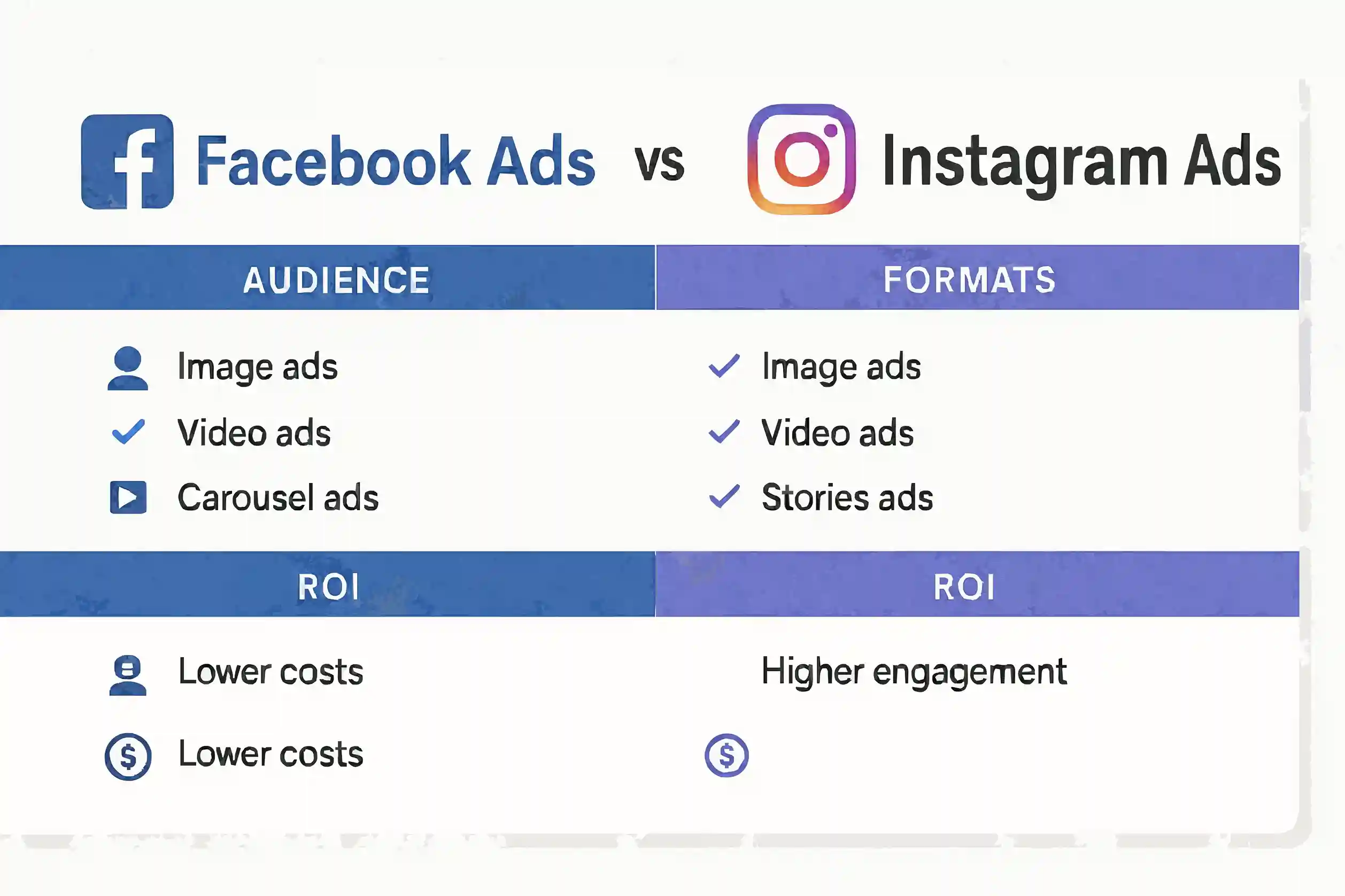I’m Mohsin, a digital marketer with over 3 years of experience managing social PPC campaigns across Facebook and Instagram. Both platforms, owned by Meta, offer powerful advertising solutions, but choosing the right one for your business in 2025 can significantly impact your ROI.
This article compares Facebook Ads and Instagram Ads based on audience demographics, ad formats, targeting capabilities, and cost-efficiency. The insights here are drawn from my hands-on experience and supported by authoritative sources such as Meta Business Help Center, WordStream, and AdEspresso. As a digital marketer with practical experience, I’ve seen firsthand how leveraging both platforms can drive results.

Audience Demographics and Reach
Facebook Ads
Facebook remains the largest social network with over 2.9 billion monthly active users worldwide. Its audience is diverse, spanning all age groups, but it has a strong presence among users aged 25-54. Facebook’s broad reach makes it ideal for businesses targeting a wide demographic. Data from Statista confirms Facebook’s continued dominance in user base.
Instagram Ads
Instagram has over 2 billion monthly active users, with a younger skew—primarily users aged 18-34. It’s a visually-driven platform popular among millennials and Gen Z, making it perfect for brands focusing on lifestyle, fashion, beauty, and entertainment sectors. Insights from Hootsuite’s Digital 2025 Report highlight Instagram’s appeal to younger demographics.
Ad Formats and Creative Options
Facebook Ads
- Image and video ads
- Carousel ads
- Collection ads
- Instant Experience (full-screen mobile ads)
- Lead generation forms
- Event promotion ads
Facebook’s diverse ad formats support various campaign objectives, from brand awareness to direct conversions. For examples of successful ad formats, check out Facebook’s Ad Examples.
Instagram Ads
- Photo and video ads
- Stories ads
- Reels ads (short-form video)
- Carousel ads
- Shopping ads with product tags
Instagram’s focus on immersive visual content and Stories/Reels formats offers unique engagement opportunities. According to Later.com, Stories ads are particularly effective for driving brand engagement and conversions.
Targeting Capabilities
Both platforms share Meta’s powerful targeting engine, including:
- Demographics (age, gender, location)
- Interests and behaviors
- Custom Audiences (website visitors, customer lists)
- Lookalike Audiences
- Detailed device and connection targeting
However, Instagram’s audience is more niche, often requiring more refined targeting strategies to reach the right users effectively. Facebook provides a detailed guide to its targeting options at Facebook Targeting Options.
Cost and ROI Comparison
Facebook Ads
Generally, Facebook Ads have a slightly lower average cost-per-click (CPC) and cost-per-thousand impressions (CPM) due to larger inventory and broader audience. However, competition varies by industry and region.
Instagram Ads
Instagram Ads tend to have higher engagement rates but can come with higher CPCs, especially in competitive verticals like fashion and beauty. The platform often delivers better ROI for brands with strong visual content and younger target audiences.
According to WordStream, businesses focused on direct conversions often see better ROI on Facebook, while brand awareness and engagement campaigns perform well on Instagram.
When to Use Facebook Ads vs Instagram Ads
| Business Goal | Facebook Ads | Instagram Ads |
|---|---|---|
| Brand Awareness | Broad reach, diverse demographics | Younger, visually engaged audience |
| Lead Generation | Effective with lead forms | Good for visually-driven leads |
| eCommerce Sales | Retargeting & dynamic ads | Shopping tags and influencer ads |
| B2B Marketing | Better targeting for professionals | Less effective for B2B |
| Engagement & Community | Groups and events promotion | Stories and Reels for interaction |
Expert Tips from Mohsin, Digital Marketer
- Use Facebook Ads if your goal is broad reach, lead generation, or B2B marketing.
- Choose Instagram Ads for highly visual brands targeting younger demographics and focusing on engagement or eCommerce.
- Test both platforms with small budgets to see which yields better ROI for your specific audience and goals.
- Leverage Meta’s Advantage+ Campaigns and AI-powered automation to optimize ad delivery. Details on Advantage+ campaigns can be found at Meta Advantage+ Campaigns.
- Continuously analyze performance metrics like CTR, CPC, conversion rate, and ROAS to refine your campaigns. Use Google Analytics to get the complete customer journey view.
Frequently Asked Questions (FAQs)
Q1: Can I run Facebook and Instagram ads simultaneously?
Yes, using Meta Ads Manager, you can run campaigns across both platforms to maximize reach.
Q2: Which platform is cheaper for advertising?
Costs vary by industry, but Facebook generally has lower CPCs; Instagram often has higher engagement but potentially higher costs.
Q3: Are Instagram Stories ads effective?
Yes, Stories ads have high engagement rates and are ideal for immersive, full-screen mobile experiences. Sprout Social offers further insights on leveraging Instagram Stories ads.
Q4: How important is ad creative on Instagram?
Extremely important; Instagram users expect high-quality, visually appealing content.
Q5: Can I target the same audience on both platforms?
Yes, Meta’s targeting system allows you to create overlapping or distinct audiences for each platform.
Conclusion
Both Facebook Ads and Instagram Ads offer powerful opportunities for advertisers in 2025. Your choice depends largely on your target audience, campaign goals, and creative assets. Facebook excels in broad reach and lead generation, while Instagram shines for highly visual brands targeting younger users.
From my experience and supported by data from WordStream and Meta, testing both platforms and leveraging their unique strengths will help you maximize ROI and build a strong social media presence.
For expert social PPC management and campaign optimization, visit DoProFlow and elevate your paid social strategy today.
As a digital marketer, I recommend starting with well-defined goals and continuously refining your strategy based on the data you gather from these powerful platforms.